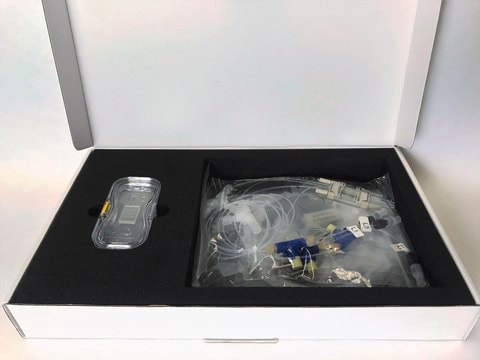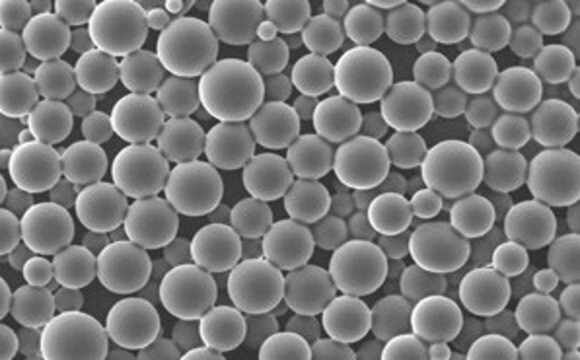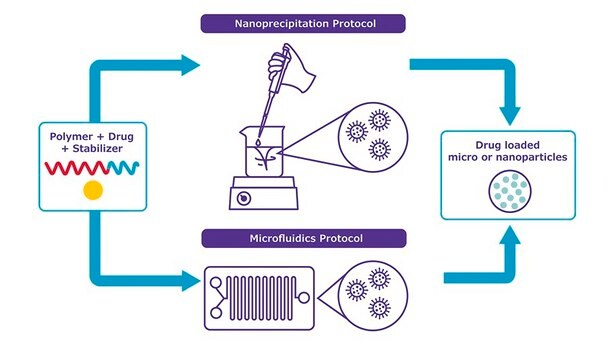おすすめの製品
詳細
PLGA nanoparticle screening kit for synthesis of 100 and 200 nm particles
品質水準
アプリケーション
advanced drug delivery
保管温度
2-8°C
関連するカテゴリー
詳細
NanoFabTx™ PLGA-nano reagent kit is a nanoformulation kit designed for the synthesis of specifically sized, drug-encapsulating poly(lactic-co-glycolic acid) (PLGA) nanoparticles. The NanoFabTx™ PLGA-nano reagent kit provides reagents (PLGA and stabilizer) and protocols to synthesize polymeric nanoparticles 75 to 200 nm in size. One protocol describes how to use the kit with standard glassware using a nanoprecipitation or solvent-displacement method. The second protocol describes how to use the kit with the NanoFabTx™ Microfluidic - nano device kit (Cat.No. 911593) for the fabrication of nanoparticles using microfluidic methods.
アプリケーション
With NanoFabTx™ PLGA-nano reagent kit, users can simplify their methods for PLGA nanoparticle synthesis and their drug loading experiments. Our protocols describe how to tune the synthetic parameters to achieve monodisperse nanoparticles 75 nm in size, 200 nm in size, or any size in between. As a result, the kit enables users to synthesize and test different particle sizes and identify the ideal size and drug loading of PLGA nanocarriers for their research application. The resulting particles are biocompatible and biodegradable and can be further modified to target specific tissues or to ensure slow and sustained drug release. PLGA is a biocompatible and biodegradable polymer that is approved by the FDA for biomedical and pharmaceutical applications and that is used widely in drug delivery systems for sustained release of many different types of therapeutic molecules. PLGA-based nanocarriers can be used to encapsulate both hydrophobic drugs like curcumin and lipophilic drugs like docetaxel. PLGA nanocarriers synthesized with the NanoFabTx™ kits are suitable for biomedical research applications such as oncology, immuno-oncology, gene delivery, and vaccine delivery. Polymeric nanoparticles are useful for intravenous or systemic delivery of drug molecules. For example, polymeric nanocarriers improve drug dissolution and solubility of hydrophobic and lipophilic drugs. In addition, the small size of polymeric nanocarriers make them much more likely than larger microparticles to bypass the reticuloendothelial system and complement system, usually leading to longer circulation half-lives. In addition, nanoparticles can pass through the blood-brain barrier, through tumor vasculature, and can enter cells via pinocytosis.
特徴および利点
- Step-by-step protocols developed and tested by our formulation scientists
- Flexible synthesis tool to create uniform and reproducible nanoparticles
- Choose from standard glassware-based nanoprecipitation or microfluidic-based protocols
- Optimized to make nanoparticles 75-200 nm nanoprecipitation or microfluidics with low polydispersity
- Based on non-toxic, biodegradable polymers
法的情報
NANOFABTX is a trademark of Sigma-Aldrich Co. LLC
関連製品
製品番号
詳細
価格
保管分類コード
11 - Combustible Solids
引火点(°F)
Not applicable
引火点(℃)
Not applicable
適用法令
試験研究用途を考慮した関連法令を主に挙げております。化学物質以外については、一部の情報のみ提供しています。 製品を安全かつ合法的に使用することは、使用者の義務です。最新情報により修正される場合があります。WEBの反映には時間を要することがあるため、適宜SDSをご参照ください。
Jan Code
909637-1KT:
909637-BULK:
909637-1EA:
909637-VAR:
最新バージョンのいずれかを選択してください:
Gaurav Kumar et al.
Critical reviews in therapeutic drug carrier systems, 29(2), 149-182 (2012-04-06)
Drug-loaded polylactide-co-glycolide (PLGA) nanoparticles have been extensively studied and have a practical impact on drug delivery. Many PLGA-based nanoformulations have reached different stages of preclinical development; however, they present distinct challenges for researchers. This review discusses some of the challenges
L Martin-Banderas et al.
Mini reviews in medicinal chemistry, 13(1), 58-69 (2012-09-15)
This article presents the potential of PLGA nanoparticles for the oral administration of drugs. Different strategies are used to improve oral absorption of these nanoparticles. These strategies are based on modification of nanoparticle surface properties. They can be achieved either
ライフサイエンス、有機合成、材料科学、クロマトグラフィー、分析など、あらゆる分野の研究に経験のあるメンバーがおります。.
製品に関するお問い合わせはこちら(テクニカルサービス)



